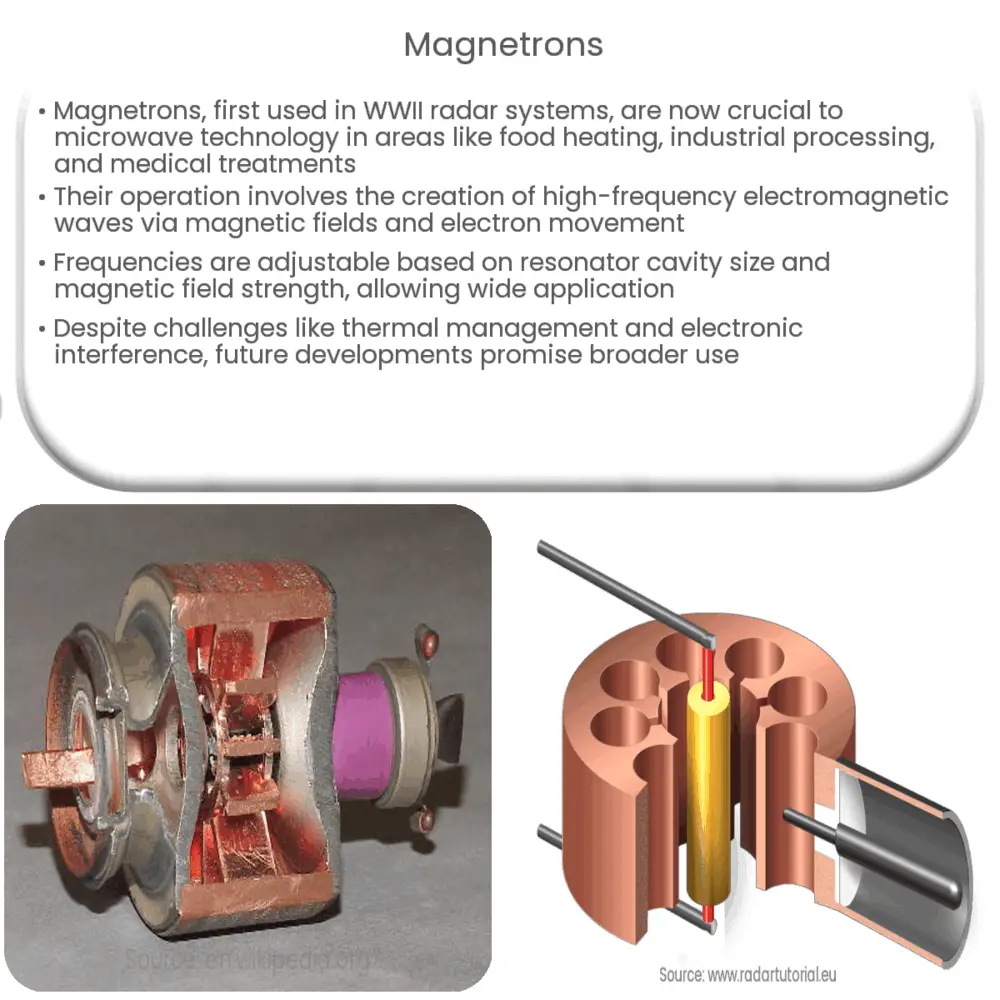Magnetrons are high-powered vacuum tubes that generate microwaves, used in radar systems, microwave ovens, communication, and medical applications.

Magnetrons: Revolutionizing Microwave Technology
Since their inception, magnetrons have played a crucial role in transforming the world of microwave technology. Initially used for radar systems during World War II, these high-powered vacuum tubes have now become indispensable components in a wide range of applications, from microwave ovens to industrial heating and plasma generation. This article provides an overview of magnetrons, their working principle, and their applications in various fields.
What is a Magnetron?
A magnetron is a specialized vacuum tube designed to generate high-frequency electromagnetic waves, primarily in the microwave range. It was invented in the 1920s by Albert W. Hull and later improved upon by British engineer Sir John Randall and physicist Harry Boot in the early 1940s. The term “magnetron” is derived from the combination of the words “magnetic” and “electron,” as the device relies on the interaction between magnetic fields and electron movement to generate microwaves.
How Do Magnetrons Work?
Magnetrons consist of a central cathode surrounded by an anode with cavities called resonators. In the presence of a strong magnetic field, electrons emitted from the heated cathode move in a circular path towards the anode. As they pass by the resonator cavities, they induce an oscillating electric field, which leads to the generation of electromagnetic waves at specific frequencies. These microwaves are then extracted through a waveguide, a structure that directs the waves to their intended application.
The frequency of the generated microwaves depends on the dimensions of the resonator cavities and the strength of the magnetic field. By altering these parameters, magnetrons can be designed to produce a wide range of frequencies suitable for various applications.
Applications of Magnetrons
Magnetrons have a plethora of applications across multiple industries, a few of which are described below:
1. Radar Systems
One of the earliest and most significant applications of magnetrons was in radar systems during World War II. The high-power microwaves generated by magnetrons enabled the development of more advanced radar systems, which could detect enemy aircraft and ships at greater distances and with higher accuracy. These radar systems played a crucial role in the outcome of the war and laid the foundation for modern radar technology.
2. Microwave Ovens
Perhaps the most well-known application of magnetrons is in microwave ovens. By generating microwaves that can penetrate food and excite water molecules, magnetrons enable rapid and efficient heating of food. The use of magnetrons in microwave ovens has revolutionized the way we cook and reheat food, making it more convenient and time-efficient.
3. Industrial Heating and Processing
Magnetrons are also used in various industrial heating and processing applications, such as drying, curing, and sterilization. They offer a fast, efficient, and uniform heating method that can be easily controlled and adjusted to suit the requirements of different materials and processes.
4. Plasma Generation
Magnetrons have found use in plasma generation for applications such as material processing, thin-film deposition, and plasma-enhanced chemical vapor deposition (PECVD). By creating a high-frequency electric field, magnetrons can ionize gases and generate plasmas, which are used to modify material properties, create coatings, or etch surfaces in various industries, including semiconductor manufacturing and aerospace.
5. Medical Applications
Medical applications of magnetrons include cancer treatment through microwave ablation and hyperthermia. These procedures use the targeted heating properties of microwaves generated by magnetrons to destroy cancerous tissue or increase the temperature of tumors, making them more susceptible to radiation therapy or chemotherapy. Additionally, magnetrons are used in some medical imaging systems, such as microwave imaging, which offers a non-ionizing alternative to X-rays and other imaging modalities.
6. Communication and Broadcasting
Magnetrons have been employed in communication and broadcasting systems, including satellite communication, television broadcasting, and data transmission. Their ability to generate high-power microwaves at specific frequencies enables the transmission of signals over long distances with minimal loss of quality and interference.
Future Developments and Challenges
As technology continues to advance, magnetrons are expected to play an increasingly important role in various applications. Research is ongoing to develop more efficient, compact, and reliable magnetrons that can operate at higher frequencies and power levels. This could open up new opportunities in areas such as wireless power transmission, advanced radar systems, and high-resolution imaging.
However, there are also challenges associated with magnetrons, such as the generation of unwanted harmonics, thermal management, and potential interference with other electronic devices. Addressing these challenges will be critical to fully realizing the potential of magnetrons in existing and emerging applications.
Conclusion
Magnetrons have come a long way since their invention nearly a century ago. Their ability to generate high-power microwaves has revolutionized numerous industries, from radar systems and microwave ovens to medical treatments and communication technologies. As research and development continue, we can expect magnetrons to further impact our lives and shape the technological landscape in new and exciting ways.



